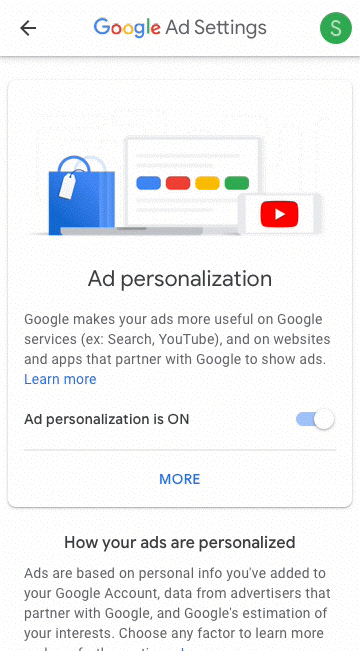Google unveils revamped Ad Settings page to reassure us about its data collection

The tech industry's wave of "transparency and control" in online advertising is now washing over Google.
Google announced on Thursday an update to its Ad Settings page to increase — you guessed it — "transparency" for users around targeted advertising. It is also expanding the reach of its "Why this ad?" feature to all Google services, and websites that use the Google ad network.
"The new Ad Settings and updates to Why this ad? provide you with more transparency and control over your Google ad experience than ever before," Google product manager Philippe de Lurand Pierre-Paul said in a statement. "With these improvements, you can browse the web confidently knowing that you have the information and control to make Google work better for you."
SEE ALSO: Thread about how much data Facebook and Google have on you will freak you the hell out
Google's updates follow similar pushes from Facebook — with whom Google shares over 60 percent of the US digital advertising market — and Apple. The renewed drive by big tech industry players to communicate how targeted advertising works comes after mass outrage about Cambridge Analytica's use of Facebook data, and to Russian companies' attempts to influence the US election through posts and ads on Facebook, Twitter, and Google — all using microtargeted advertising. Google, along with Facebook and Twitter, faced congressional hearings about this issue last fall.

Image: google
Google has had Ad Settings and Why this ad? features for years. Ad Settings is a portal that allows Google users to turn targeted advertising (called 'Ad personalization') on or off. It's also where people can see, and make changes to, the specific interest and demographic information that Google collects and uses to target ads. The change today is a redesign in the images and languages Google uses to communicate the info.
Why this ad? is a feature that accompanies actual ads across Google products and the internet. Clicking on "Why this ad?" when it pops up in an advertisement shows the information Google used when determining to show you the particular advertisement. Since 2012, Google users have also had the ability to "Mute" ads. Previously, the prompt showed up on Google Ad Words and Gmail products. Today's expansion brings the "Why this ad?" product to advertisements on Google products and on websites that utilize the Google ad network.

Image: google
Both of these changes take the approach that giving people more accessible and easy-to-understand information about how Google collects personal data for advertising, will make people more comfortable with the fact that Google does collect and utilize its users information. The problem these changes seem to address is that people don't understand how targeted ads work — not that the problem are the data-based ads themselves.
Targeted ads comprise the core of Google's (and Facebook's) business model; the ability to reach very specific sets of consumers, based on personal information gleaned from online activity, is what has made the Google and Facebook ad networks so valuable to advertisers. So, despite public outcry driven by renewed awareness about just how much data these companies collect on their users, these tech giants can't just do away with their advertising products. The answer, instead, is a push toward "transparency and control," as Google put it.
This is a fair move, too, considering that so much of the anger about targeted ads came from the fact that people did not really know about how their data was being collected and used. Now, with the plain language and easy to navigate sites like Google's Ad Settings, Google users should actually be more aware and be empowered to control how companies collect their data.
Today's announcement doesn't provide much in the way of material changes to Google's advertising initiatives. It's more of a way to demonstrate to the public, and to Congress, that its tactics aren't shady.
And, of course, that it's doing just as much as the other guys to make a change.
WATCH: Watch Zuckerberg’s face freeze after a far-right politician credited Facebook for Trump's win and Brexit


 Yahoo Finance
Yahoo Finance 